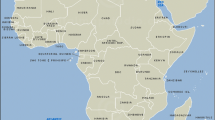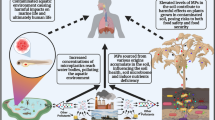Abstract
The concentrations of hexachlorocyclohexanes (HCHs) were investigated in urban soil samples collected from business area, classical garden (CL), culture and educational area, large public green space (LA), residential area, and roadside area in Beijing. HCH concentrations ranged from 0.32 to 136.43 ng/g, with a geometric mean of 3.46 ng/g. The HCH concentrations in CL and LA were much higher than that in the other types of land use, which was due to the usage of HCHs to protect vegetation in CL and LA. Source identification showed that contamination source of HCHs was derived from historical HCHs (including technical HCHs and Lindane) as well as the long-range atmospheric transportation of HCHs. HCH concentrations showed a decreasing trend from the city centre to the suburb, and it increased with the age of the urban area. HCHs were negatively correlated with pH and positively correlated with total organic carbon and black carbon in soils. Health risk assessment with CalTOX and Monte Carlo analysis showed that health risks mainly came from dermal uptake and inhalation exposure pathways, and the total risk values were lower than the acceptable health risk value (10 − 6). The sensitivity analysis indicated that the reaction half-life of HCHs in soil, fraction dermal uptake from soil, exposure duration, and organic carbon fraction in soil significantly contributed to the variance of the health risk.
Similar content being viewed by others
References
Abrahams, P. W. (2002). Soils: Their implications to human health. Science of the Total Environment, 209, 1–32.
Aichner, B., Glaser, B., & Zech, W. (2007). Polycyclic aromatic hydrocarbons and polychlorinated biphenyls in urban soils from Kathmandu, Nepal. Organic Geochemistry, 38, 700–715.
Alawi, M., Khalili, F., & Da’as, K. (1995). Interaction behavior of organochlorine pesticides with dissolved Jordanian humic acid. Archives of Environment Contamination and Toxicology, 28, 513–518.
American Society for Testing and Materials (2000). Standard guide for risk-based corrective action. E2081–00. West Conshohocken, ASTM.
Banat, K. M., Howari, F. M., & Al-Hamad, A. A. (2005). Heavy metals in urban soils of central Jordan: Should we worry about their environmental risks? Environmental Research, 97, 258–273.
Boehm, P. D., & Farrington, J. W. (1984). Aspects of the polycyclic aromatic hydrocarbon geochemistry of recent sediments in the Georges Bank region. Environmental Science and Technology, 18, 840–845.
Borisover, M. D., & Graber, E. R. (1997). Specific interaction of organic compounds with soil organic carbon. Chemosphere, 34, 1761–1776.
Boyd, H. B., Pedersen, F., Cohr, K. H., Damborg, A., Kristensen, P., & Samsøe-Petersen, L. (1999). Exposure scenarios and guidance values for urban soil pollutants. Regulatory Toxicology and Pharmacology, 30, 197–208.
Cai, Q. Y., Mo, C. H., Wu, Q. T., Katsoyiannis, A., & Zeng, Q. Y. (2008). The status of soil contamination by semivolatile organic chemicals (SVOCs) in China: A review. Science of the Total Environment, 389, 209–224.
Carvalho, P. N., Rodrigues, P. N. R., Basto, M. C. P., & Vasconcelos, M. T. S. D. (2009). Organochlorine pesticides levels in Portuguese Coastal Areas. Chemosphere, 75, 595–600.
Chang, S. H., Kuo, C. Y., Wang, J. W., & Wang, K. S. (2004). Comparison of RBCA and CalTOX for setting risk-based cleanup levels based on inhalation exposure. Chemosphere, 56, 359–367.
Chen, T. B., Zheng, Y. M., Huang, Z. C., Wu, H. T., Chen, H., Fan, K. K. et al. (2005). Assessment of heavy metal pollution in surface soils of urban parks in Beijng, China. Chemosphere, 60, 542–551.
Chen, Y. C., & Ma, H. W. (2006). Model comparison for risk assessment: A case study of contaminated groundwater. Chemosphere, 63, 751–761.
Chen, X., Xia, X. H., Wu, S., Wang, F., & Guo X. J. (2010). Mercury in urban soils with various types of land use in Beijing, China. Environmental Pollution, 158, 48–54.
Covaci, A., Hura, C., & Schepens, P. (2001). Selected persistent organochlorine pollutants in Romania. Science of the Total Environment, 280, 143–152.
Falandysz, J., Brudnowska, B., Kawano, M., & Wakimoto, T. (2001). Polychlorinated biphenyls and organochlorine pesticides in soils from the southern part of Poland. Archives of Environment Contamination and Toxicology, 40, 173–178.
Fu, J., Mai, B., Sheng, G., Zhang, G., Wang, X., Peng, P., et al. (2003). Perssistent organic pollutants in enviroment of the Pearl River Delta, China: an overview. Chemosphere, 52, 1411–1422.
Fu, S., Cheng, H. X., Liu, Y. H., & Xu, X. B. (2009). Levels and distribution of organochlorine pesticides in various media in a mega-city, China. Chemosphere, 75, 588–594.
Fu, S., Chu, S. G., & Xu, X. B. (2001). Organochlorine pesticide residue in soils from Tibet, China. Bulletin of Environment Contamination and Toxicology, 66, 171–177.
Haugen, J. E., Wania, F., Ritter, N., & Schlabach, M. (1998). Hexachlorocyclohexanes in air in southern Norway: Temporal variation, source allocation, and temperature dependence. Environmental Science and Technology, 32, 217–224.
Imperato, M., Adamo, P., Naimo, D., Arienzo, M., Stanzione, D., & Violante, P. (2003). Spatial distribution of heavy metals in urban soils of Naples city (Italy). Environmental Pollution, 124, 247–256.
Jiang, Y. F., Wang, X. T., Sun, Y. Z., Wang, F., Wu, M. H., Sheng, G. Y. et al. (2010). Residues of organochlorine pesticides in urban soil of Shanghai. Environmental Science, 31, 409–414.
Jones, K. C., & de Voogt, P. (1999). Persistent organic pollutants (POPs): State of the science. Environmental Pollution, 100, 209–221.
Kalbitz, K., Popp, P., Geyer, W., & Hanschmann, G. (1997). β-HCH mobilization in polluted wetland soils as influenced by dissolved organic matter. Science of the Total Environment, 204, 37–48.
Katsoyiannis, A., Zouboulis A., & Samara, C. (2006). Persistent Organic Pollutants (POPs) in the Conventional Activated Sludge Treatment Process: Model Predictions Against Experimental Values. Chemosphere, 65, 1634–1641.
Li, X. D., Poon, C. S., & Liu, P. S. (2001). Heavy metal contamination of urban street dusts in Hong Kong. Applied Geochemistry, 16, 1361–1368.
Li, X. H., Wang, W., Wang, J., Cao, X. L., Wang, X. F., Liu, J. C. et al. (2008). Contamination of soils with organochlorine pesticides in urban parks in Beijing, China. Chemosphere, 70, 1660–1668.
Li, X. H., Zhu, Y. F., Liu, X. F., Fu, S., Xu, X. B., & Cheng, H. X. (2006). Distribution of HCHs and DDTs in soils from Beijing City, China. Archives of Environment Contamination and Toxicology, 51, 329–336.
Li, Y. F., Cai, D. J., & Singh, A. (1998). Hexachlorocyclohexane use trends in China and their impact on the environment. Archives of Environment Contamination and Toxicology, 35, 688–697.
Mackay, D., Shiu, W. Y., & Ma, K. C. (1997). Illustrated Handbook of Physical-Chemical Properties of Environmental Fate of Organic Chemicals. vol. V. Boca Raton: Lewis.
Nakata, H., Kawazoe, M., Arizono, K., Abe, S., Kitano, T., Shimada, H. et al. (2002). Organochlorine pesticides and polychlorinated biphenyl residues in foodstuffs and human tissues from China: status of contamination, historical trend, and human dietary exposure. Archives of Environment Contamination and Toxicology, 43, 473–480.
Presidential/Congressional Commission on Risk Assessment and Risk Management (1997). Risk assessment and risk management in regulatory decision making. Final report. 2.
Ran, Y., Sun, K., Yang, Y., Xing, B. S., & Zeng, E. (2007). Strong sorption of phenanthrene by condensed organic matter in soils and sediments. Environmental Science and Technology, 41, 3952–3958.
Ribes, A., & Grimalt, J. O. (2002). Temperature and organic matter dependence of the distribution of organochlorine compoundsin mountain soils from the subtropical Atlantic (Teide, Tenerife Island). Environmental Science and Technology, 36, 821–827.
Schnitzer, M., & Khan, S. (1978). Soil organic matter. Amsterdam: Elsevier, pp. 1–64 and 137–171.
Thorson, W. A., Cope, W. G., & Shea, D. (2004). Bioavailability of PAHs: effects of soot carbon and PAH source. Environmental Science and Technology, 38, 2029–2037.
Tiller, K. G. (1992). Urban soil contamination in Australia. Australian Journal of Soil Research, 30, 937–957.
US EPA (1989). Risk assessment guidance for superfund: human health evaluation manual, vol. 1 (Part A). Washington: Office of Emergency and Remedial Response.
Vryzas, Z., & Euphemia, P. M. (2002). Determination of triazine and chloroacetanilide herbicides in soils by Microwave-Assisted Extraction (MAE) coupled to gas chromatographic analysis with either GC-NPD or GC-MS. Journal of Agricultural and Food Chemistry, 50, 5026–5033.
Walker, K., Vallero, D. A., & Lewis, R. G. (1999). Factors influencing the distribution of lindane and other hexachlorocyclohexanes in the Environment. Environmental Science and Technology, 33, 4373–4378.
Wang, W., Li, X. H., Wang, X. F., Wang, X. Z., Lu, H., Jiang, X. N. et al. (2009). Levels and chiral signatures of organochlorine pesticides in Urban Soils of Yinchuan, China. Bulletin of Environment Contamination and Toxicology, 82, 505–509.
Wang, X. F., Wang, D. Z., Qin, X. F., & Xu, X. B. (2008). Residues of organochlorine pesticides in surface soils from college schoolyards in Beijing, China. Journal of Environmental Sciences, 20, 1090–1096.
Wenzel, K. D., Manz, M., Hubert, A., & Schüürmann, G. (2002). Fate of POPs (DDX, HCHs, PCBs) in upper soil layers of pine forests. Science of the Total Environment, 286, 143–154.
Willett, K. L., Ulrich, E. M., & Hites, R. A. (1998). Differential toxicity and environmental fates of hexachlorocyclohexane isomers. Environmental Science and Technology, 32, 2197–2207.
Wu, S. P., Cao, J., Li, B. G., Xu, F. L., Shen, W. R., Han, B. P. et al. (2003). Residues and distribution of organochlorine pesticides in airborne particles of different sizes from urban areas. Res. Environmental Science & Research, 16, 36–39.
Wu, W. Z., Xu, Y., Schramm, K.W., & Kettrup, A. (1997). Study of sorption, biodegradation and isomerization of HCH in stimulated sediment/water system. Chemosphere, 35, 1887–1894.
Xu, D., Dan, M., Song, Y., Chai, Z., & Zhuang, G. (2005). Concentration characteristics of extractable organohalogens in PM2.5 and PM10 in Beijing, China. Atmospheric Environment, 39, 4119–4128.
Yang, L. Y., Xia, X. H., Liu, S. D., & Bu Q. W. (2010). Distribution and Sources of DDTs in Urban Soils with Six Types of Land Use in Beijing, China. Journal of Hazardous Materials, 174, 100–107.
Yang, W. R., Wang, R. S., Zhou, C. B., & Li, F. (2009). Distribution and health risk assessment of organochlorine pesticides (OCPs) in industrial site soils: A case study of urban renewal in Beijing, China. Journal of Environmental Sciences, 21, 366–372.
Zhang, H. B., Luo, Y. M., Zhao, Q. G., Wang, M. H., & Zhang, G. L. (2006). Residues of organochlorine pesticides in Hong Kong soils. Chemosphere, 63, 633–641.
Zhang, H., Lu, Y. L., Dawson, R. W., Shi, Y. J., & Wang, T. Y. (2005). Classification and ordination of DDT and HCH in soil Samples from the Guanting Reservoir, China. Chemosphere, 60, 762–769.
Zhang, Z. L., Huang, J., Yu, G., & Hong, H. S. (2004). Occurrence of PAHs, PCBs and organochlorine pesticides in Tonghui River of Beijing, China. Environmental Pollution, 130, 249–261.
Zhu, Y. F., Liu, H., Xi, Z. Q., Cheng, H. X., & Xu, X. B. (2005). Organochlo-rine pesticides (DDTs and HCHs) in soils from the outskirts of Beijing, China. Chemosphere, 60, 770–778.
Author information
Authors and Affiliations
Corresponding author
Electronic Supplementary Material
Below is the link to the electronic supplementary material.
Rights and permissions
About this article
Cite this article
Yang, L., Xia, X. & Hu, L. Distribution and Health Risk Assessment of HCHs in Urban Soils of Beijing, China. Environ Monit Assess 184, 2377–2387 (2012). https://doi.org/10.1007/s10661-011-2124-5
Received:
Accepted:
Published:
Issue Date:
DOI: https://doi.org/10.1007/s10661-011-2124-5




